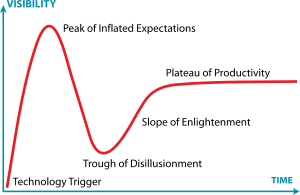 Gartner’s Hype Cycle looks at the various phases many new technologies go through when they first hit the marketplace. A key phase is the peak of inflated expectations, where hype generally runs free and unrealistic expectations are had for a particular technology.
Gartner’s Hype Cycle looks at the various phases many new technologies go through when they first hit the marketplace. A key phase is the peak of inflated expectations, where hype generally runs free and unrealistic expectations are had for a particular technology.
The technology suffers for this inflated sense of expectation, and a trough of disillusionment follows as those expectations aren’t met, before more realistic achievements are made (or alternatively the technology drifts away).
It’s hard to ignore the huge impact MOOCs have made over the past 18 months, with courses regularly attracting over 100,000 registrants. With such popularity has come claims that they are going to revolutionise tertiary education.
Is that a realistic expectation, or are they following the hype cycle of inflated expectations? If you ask San Jose University they might think just that. They announced this week that they are suspending their for credit courses on the Udacity website after more than half of those who enrolled on their courses failed to pass them.
In their math related courses pass rates varied from 20% to 44%. The end of the experiment represents a blow for MOOC sites hoping to use the San Jose experiment to encourage other schools to offer for credit courses via their platforms.
“There are many complex factors that relate to student performance, and we’re trying to study the factors that help or hinder students in this environment,” said San Jose State Provost Ellen Junn.
The courses had an initial class of 100 students and were supported by the National Science Foundation. In addition to math related courses, ones on computer science and psychology were offered, with students paying $150 for the course.
Is this a sign that MOOC courses are not fit for taking the place of traditional courses, or simply showing that more refinement is needed for them to make a serious dent in the university market? An official statement by San Jose and Udacity suggests the latter
“The improvements we are considering include developing introductory materials that will help students prepare for and engage in college-level online classes. We would also like to look at the impact of the frequency of quizzes for grades and other similar incentives to help students move through the material in a timely manner. Another focus will be to explore opportunities to move to open-registration, self-paced classes with student-set deadlines.”
It appears that not enough was done to ensure students were sufficiently prepared for the course before beginning. For instance, many students did not even have a computer, which was something the course mentors did not become aware of for several weeks.“We learned that we could have prepared them better about what it means to take an online course and that this is a university course with real faculty teaching for university credit,” they said. “Maybe some students didn’t take it quite seriously.”
Students in the summer courses received more support, and initial evidence suggests their results will be better. The suspension of the courses for the remainder of the year will allow the school to assess how the courses went and what lessons can be learnt. The plan is to resume the course again in the spring.
I don't know if the shine is coming off as such, but it's inevitable that the model will evolve as both 'students' and suppliers adapt to things. Such has been the popularity it seems inevitable that they will impact traditional education in some way, it's just a case of figuring out how.
I can see how MOOCs could be helpful for the "information stuffing" aspects of the university like lectures in low level courses. However, at the higher levels in the humanities and social sciences (for example), where the object is to engage in critical dialogue with the the previous "information stuffing" and develop new knowledge, I can't see a substitute for face to face learning. I've taken correspondence courses (which have been around for over 100 years) and online courses before, and they really do help plug some knowledge gaps, but destroying the old reliable seminar or discussion section would be a huge mistake.
There are some things that traditional universities can provide which MOOCs will have a difficulty providing.
These include:
1. Mentoring
2. Networking
3. Laboratory work
4. Group work
I agree that as far as lecturing goes, that the universities should be scared. However, I don't think that is the primary value added thing that universities provide. The primary value added thing is and always has been Networking.
MOOCs are good for most classes except those that require lots of lab time, e.g. mechanical engineering and natural sciences. The fact that many drop out says more about the quality of the students than the quality of the teachings.
I've completed several online courses. Many were great, some were lousy. MOOCs are an excellent way to transmit and disseminate knowledge. In that they are akin to books rather than universities.
I agree with many of the comments made above. Universities provide much more than what can be disseminated through MOOCs. Is the shine coming off? I guess it was to be expected, but it doesn't mean they'll go away. As the Hype Cycle shows, it's just a normal phase in the adoption process by mainstream population and students.
Great post, Adi.
Frederic
Thanks for stopping by Frederic. It'll certainly be interesting to see where things head over the next few years as the sector begins to settle down a bit, especially as Coursera et al begin to try and commercialise their model.